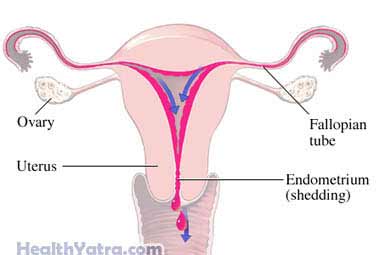Painful Menstrual Periods Definition
Painful menstrual periods (also called dysmenorrhea) may include pain in the abdomen, back and legs; abdominal cramps; headache; and fatigue. Most women have painful periods at some time in their lives. In some women, the pain is severe enough to interfere with normal activities.
There are two types of dysmenorrhea:
- Primary dysmenorrhea—painful regular (ovulatory) menstrual cycles caused by uterine muscle contractions (due to high levels of prostaglandins produced in the lining and body of the uterus after ovulation)
- Secondary dysmenorrhea—painful periods due to an underlying condition, such asendometriosis (a condition involving the lining of the uterus) or infection

Causes
Primary dysmenorrhea is caused by high levels of prostaglandins in the uterus. Prostaglandins are hormone-like substances normally found throughout the body.
Secondary dysmenorrhea can be caused by:
- Endometriosis
- Ovarian cysts
- Pelvic inflammatory disease (infection of the female reproductive organs)
- Uterine fibroids (noncancerous growths in the uterus)
- Intrauterine device (IUDs)
- Scars inside the abdomen from previous surgery
- Tumors
- Inflammatory bowel disease
Risk Factors
Risk factors include:
- Ovulatory menstrual cycles (a normal condition)
- Age: younger than 20 years old
- Early onset of menstruation (younger than 12 years old)
- Depression or anxiety
- Attempts to lose weight (in women 14-20 years old)
- Heavy bleeding during periods
- Nulliparity (never having delivered a baby)
- Smoking
You are also at risk if you have a related condition, such as endometriosis or ovarian cysts.
Symptoms
The pain associated with either primary or secondary dysmenorrhea may be sharp and throbbing or dull and aching. It is most typically located in the lower abdomen and may radiate to the low back or thighs. Other symptoms may include:
- Nausea
- Vomiting
- Diarrhea
- Headache
- Irritability
When Should I Call My Doctor?
Call your doctor if you have:
- Severe or unusual cramps
- Cramps that last for more than a few days
- Signs of infection, such as fever or chills
- Cramps with heavy menstrual bleeding
- Abdominal or pelvic tenderness
- Vaginal discharge (other than menstrual bleeding)
Also, call you doctor if you are having vaginal bleeding or pain and are unsure if it is related to menstruation.
Diagnosis
Your doctor will ask detailed questions about your symptoms and medical history, and perform a pelvic examination.
Tests that may be done to look for causes of secondary dysmenorrhea include:
- Pelvic ultrasound —a test that uses sound waves to examine structures in the pelvis
- Hysteroscopy —a test that uses a long, thin telescope with a camera on one end to view the inner uterus
- Hysterosalpingogram —a test that uses x-rays to view the uterus and fallopian tubes
- Pelvic laparoscopy —a test that uses a thin, lighted tube to view structures in the pelvis
Treatment
Primary dysmenorrhea is usually treated with medicines and lifestyle changes.
The treatment of secondary dysmenorrhea varies depending on the underlying condition (for example, antibiotics for an infection, surgery to remove fibroids).
Medications
Nonsteroidal anti-inflammatory drugs (NSAIDs), available over-the-counter, are usually the first-line treatment for menstrual pain. Examples of these medicines include ibuprofen and naproxen .
Birth control pills may be prescribed in some cases.
Other Treatments
- To help ease discomfort, place a heating pad on your abdomen or lower back. Taking a warm bath may also be helpful.
- Exercise regularly, which may help to reduce menstrual cramps.
- Find out if alternative treatments are a good option for you, for example:
- Some herbs and supplements may be helpful, such as vitamin B1,magnesium, and Chinese Herbal Medicine. Talk to your doctor before taking any herbs and supplements. They may interact with your other medicines and conditions.
- Acupuncture may also help to reduce pain.
Prevention
To help reduce your chance of painful menstrual periods, take the following steps:
- Exercise regularly.
- If you smoke, quit.
- Drink only moderate amounts of caffeine and alcohol.
